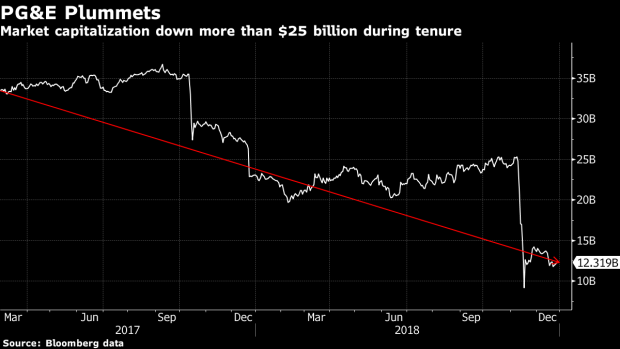Jan 13, 2019
PG&E CEO to Leave With Utility at Brink of Bankruptcy
, Bloomberg News

(Bloomberg) -- PG&E Corp. Chief Executive Officer Geisha Williams is leaving as California’s largest utility owner nears potential bankruptcy.
The San Francisco-based company has begun a search for a new CEO following Williams’ departure, according to a statement issued Sunday. PG&E general counsel John Simon will take the helm in the meantime. Williams, 57, took over as CEO in March 2017 and is leaving after a catastrophic three months for PG&E.
The company has seen two-thirds of its market value wiped out since November’s Camp Fire -- the deadliest wildfire in California’s history. Its debt has been downgraded to junk and state regulators have called for a management shakeup. Investigators have been probing whether the power giant’s equipment ignited the fire, along with its potential liability for blazes that devastated Northern California’s wine country in 2017 -- costs that may tally as much as $30 billion.
Williams couldn’t immediately be reached for comment Sunday.
The company’s deepening financial crisis has forced California regulators and policy makers to consider a bailout package and PG&E is weighing whether to file for bankruptcy. The utility is planning to notify employees as soon as Monday that it may make a Chapter 11 filing within 15 days, people familiar with the plan said Saturday. Such a notice would be required by state law.
The departure of Williams -- one of the world’s most powerful women in business -- thins the ranks of the roughly two dozen women running S&P 500 companies. She was one of a group of women occupying the C-suite at power companies -- including Duke Energy Corp.’s Lynn Good, El Paso Electric Co.’s Mary Kipp, PNM Resources Inc.’s Pat Vincent-Collawn and Sunrun Inc.’s Lynn Jurich.
The daughter of Cuban political refugees, Williams became the nation’s first Latina CEO of a Fortune 500 company when she took over PG&E. Her departure follows the exit of three PG&E executives earlier this month -- Patrick Hogan, senior vice president of electric operations at PG&E’s utility unit; Kevin Dasso, vice president of electric asset management; and Gregg Lemler, vice president of electric transmission.
Under Williams, PG&E spent millions of dollars trying to convince state lawmakers to change a legal doctrine known as inverse condemnation, under which utilities are liable for damages if their equipment is found to have sparked a wildfire, even if they weren’t negligent. Williams called the doctrine bad public policy that made utilities the default insurer in the state. She said the wildfires were a symptom of climate change with hotter and drier conditions sparking more frequent and intense blazes.
While state lawmakers rejected PG&E’s request to change wildfire liability law, they did pass legislation in August that will help PG&E pay for lawsuits arising from the wine country fires. Three months later, however, the utility’s equipment again was being looked at as a possible source of the Camp Fire, which killed 86 people and destroyed the town of Paradise.
Support for PG&E’s management eroded even further in December when state regulators accused the utility of falsifying records related to locating and marking underground gas lines from 2012 through 2017 -- years in which the company was trying to convince the public that it had cleaned up its act after a 2010 pipeline blast that killed eight in San Bruno, California.
The disclosure prompted a key state lawmaker, Bill Dodd, a state senator from Napa who helped draft the fire legislation that was helpful to PG&E, to call for a management shakeup at the company.
“Enough is enough,” Dodd said.
--With assistance from David R. Baker and Peter Blumberg.
To contact the reporters on this story: Mark Chediak in San Francisco at mchediak@bloomberg.net;Kiel Porter in New York at kporter17@bloomberg.net
To contact the editors responsible for this story: Lynn Doan at ldoan6@bloomberg.net, Ramsey Al-Rikabi
©2019 Bloomberg L.P.


